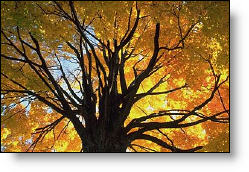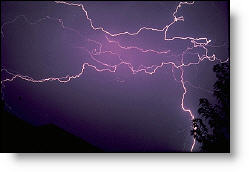Actually, all trees attract lightning. They are tall and usually filled with moisture, thus providing a good electrical conducting path for lightning. Every day, thousands of trees are hit by lightning throughout the world.

Past studies of the kinds of trees struck are complicated. It depends on tree height, the variety of trees present, and soil conditions. Overall, the oak tree appears to be most vulnerable:
“Beware the oak; it draws the stroke.”

Oaks tend to be taller than the surrounding trees, thus attracting the lightning. They also have a high moisture content, which increases their ability to conduct the surge of electricity.
When a tree is hit be lightning, most of the electrical charge moves through the outer, growing portion of the tree. This intense current can instantly vaporize sap into steam. As a result, the tree may violently split or even explode.
About half of all trees struck by lightning survive for the moment. However, they are often weakened and made susceptible to future disease.
A target tree is better off if struck after it has been thoroughly soaked by rain. Much of the electrical charge is then able to move safely down the outside surface moisture instead of through the internal tree.
Author: Dr. Donald B. DeYoung of Creation Research Society (ChristianAnswers.Net team member). First published in Weather and the Bible (Grand Rapids: Baker Book House Company, 1992). Used by permission. Copyright © 2004, Donald B. DeYoung.



